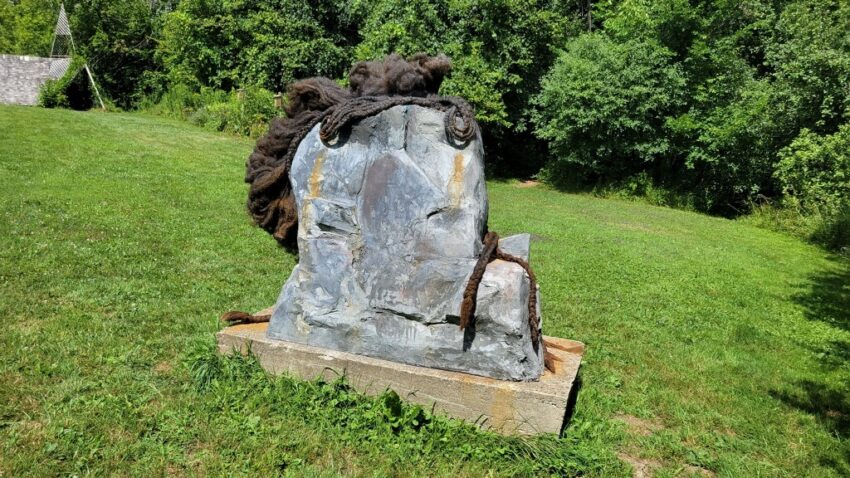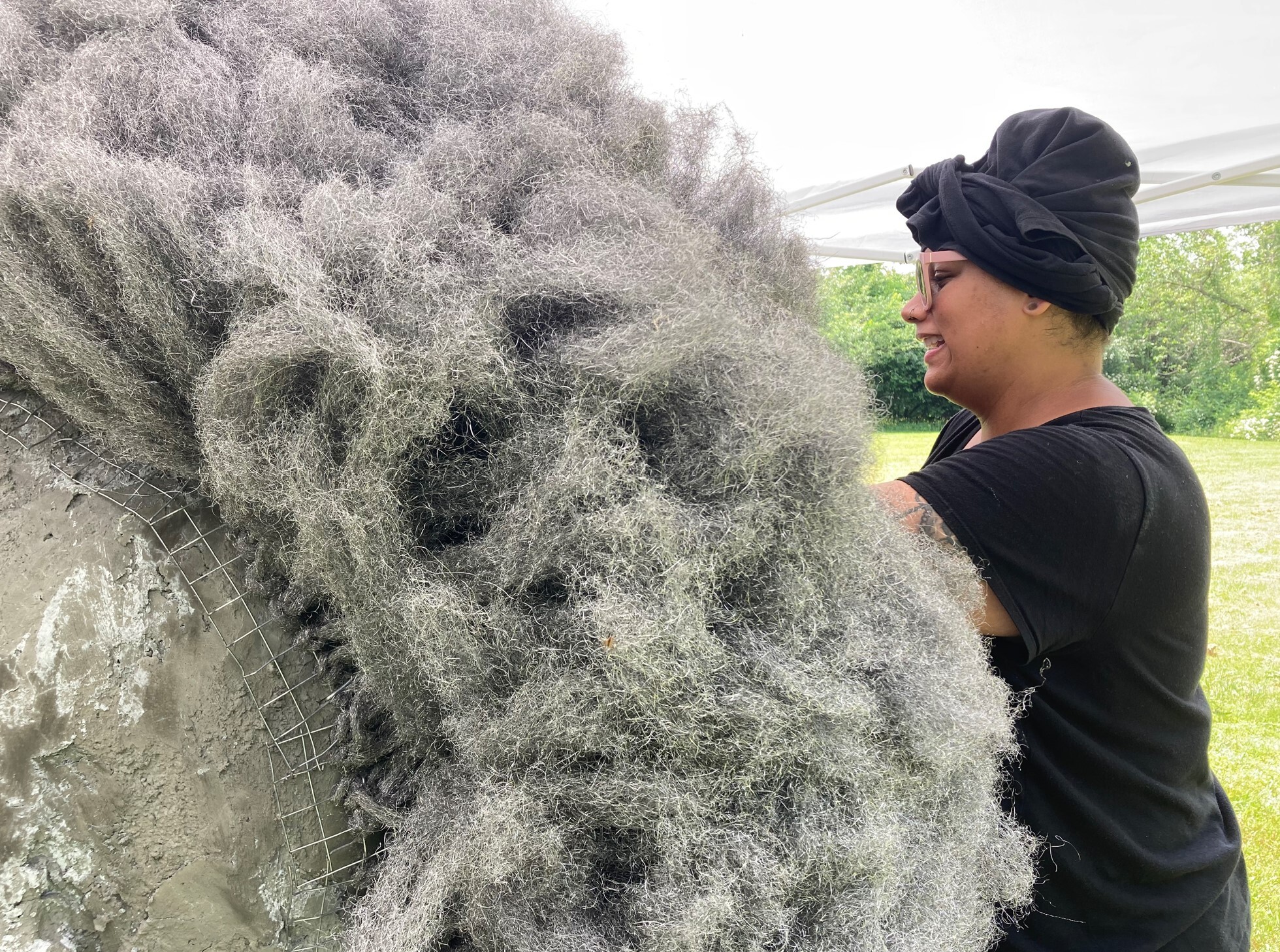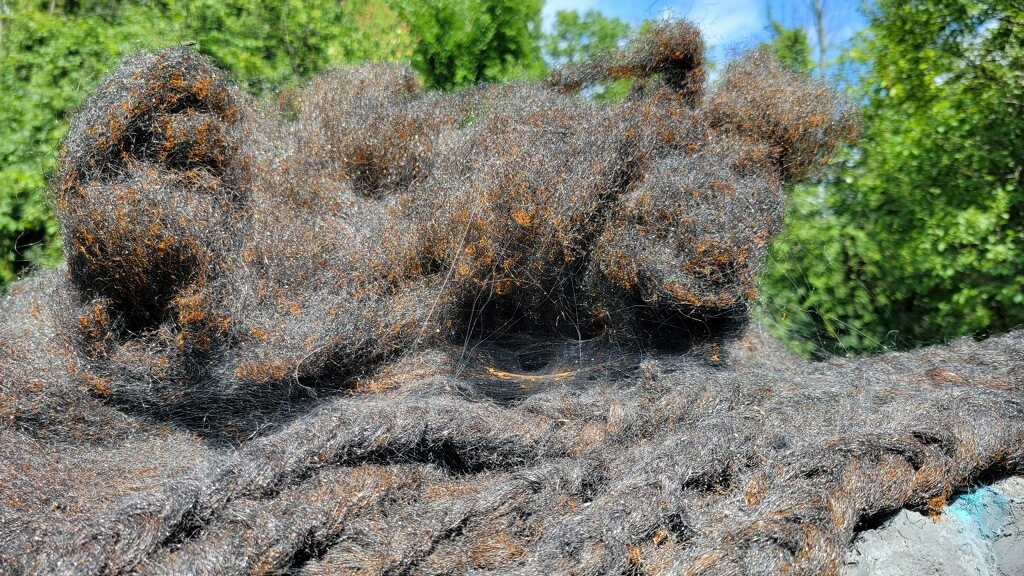 Jen Dawson, Super Natural, 2022. Image credit: Mary Ivy Martin
Jen Dawson, Super Natural, 2022. Image credit: Mary Ivy Martin
Jen Dawson - Super Natural
A conversation with Jen Dawson
In June, we welcomed visiting artist Jen Dawson to the grounds. We gathered for a conversation with Jen about her artistic process and new sculptural work, Super Natural, currently on view on the grounds. The conversation included CEO Emily Zaengle, artistic director Sayward Schoonmaker, visiting teaching artist Jessica Hyatt, and graduate intern Megan McIntyre. Below is an excerpt from our conversation. Jen Dawson's Super Natural, 2022, steel wool, steel mesh, cement is currently on view in the Secret Garden.
Sayward: We’ve had conversations preceding your arrival around the kind of work that you've been making and thinking about. You’ve been at the park for 8 days with a plan in mind for a new sculpture. Once you saw the site in the Secret Garden, you did what every great artist does: you reacted to the site, made new decisions within the site’s constraints, and ultimately found marvelous possibilities and solutions that changed the course of the work. You’ve titled the work Super Natural. Can you talk about the title’s significance?
Jen: This work is the second piece I’ve made with steel wool. I named the first work Super Natural as well. I like that the words can be interpreted in different ways: Super natural, super natural, supernatural.
Sayward: You mentioned in previous conversations that the title is drawn from a specific song?
Jen: Yes, there's a Ben E. King song called ‘Supernatural Thing.’ It's a funk song I really like. It's got a good hook with some sassy background singers in it. I can't resist it. There’s something about the word play inherent to Super Natural, for me, that goes along with the idea of working with materials in nature, that a material is not actually what you think it is.
Sayward: I'm thinking of the words ‘super’ and ‘superlative.’ You’ve taken a familiar material—steel wool—but you’ve handled a great quantity of it, which transforms the steel wool from the regular to the superlative. How much steel wool is incorporated into the sculpture?
Jen: It’s about 35 pounds of steel wool!

Jen making Super Natural this past June.
Sayward: We’ve talked about your attraction to certain ‘everyday’ materials that are easily accessible: Materials you find in a grocery store, in a hardware store. How did you come to these materials and what attracts you to them?
Jen: In my practice, I work with materials that have an informed meaning woven into them. I’ve worked a lot with hair. Hair is racially charged, sexually charged, and charged with gender. It's got all this stuff on top of it, and so I really like using it because it has all these ways in which it can take hold of people. I gravitated towards steel wool because it can so easily resemble hair. Steel wool specifically spoke to the experience of being a black person. People I grew up around often didn’t know what to do with me. The steel wool spoke to the comparisons of the Brillo pad to black hair and the kind of desire to reach out and touch the hair. So, I’m using steel wool as a way to flip it back on the viewer whether they acknowledge that or not. It is a way for me to put that desire of touch back out there. I like materials that are easy for me to get, that I can put a lot of meaning into, that hold a lot. It's always something that's very charged, whether it's steel, wool or actual hair or concrete, Pantyhose and Spandex. Whatever you can treat or hold or stretch or move in a way that somebody can see it and be like, “OK, I'm looking at this in a way that I haven't seen it before.”
Sayward: That treatment of material is prominent in Super Natural. I think viewers will encounter this work and have a moment of puzzle of what it might be. Not only is there a reveal as you move around the piece, but a reveal as you get closer to the materials. Can you talk about the role of seduction and recoil, hide and reveal in your work? There are places that you choose to expose the structure and materials of the sculpture. When you started making, you began with steel mesh that served as an armature to hold hundreds of steel wool strands, which obscured the mesh. When the wool/mesh became part of the concrete monolith, you actively chose to keep parts of steel mesh revealed. Can you talk about those choices?
Jen: I don't like art that's so tight and so put together that you look at it and think, “OK well. There's a thing, and that looks really nice and put together and I don't know how anyone did it!” I would like somebody to know the materials I use, the way in which I handled those materials, to see the artist’s hand in it. To see the way that I’ve troweled on cement: it's not something that's poured. It's not a perfect mold. It's not something that's fussed over a whole lot. The mesh is put into the cement, but it's not hidden because I don't like it to be hidden. I want somebody to be able to look closer and see what it is. The idea of somebody being able to look closer at something and get all the answers that they need, to me, is important, at least when looking at my work.
Sayward: This work will change very rapidly because of the nature of the materials: the wool will rust. What is the role of change, the allowance of change and transformation in the work?
Jen: There was a phase in my art making practice where I purposefully made work that would deteriorate into nothing, absolutely nothing.
Sayward: What were those materials?
Jen: Raw clay, mostly, so that it would just turn back into dirt. Or dust. It was a painstaking kind of effort to model or mold something into this recognizable form that took a lot of my time and energy, and then purposefully have it disintegrated into nothing. For me that was a kind of cathartic release, a feeling that I don't need this. I don't need to feel the need to control how this ends up. I also don't have any desire to hang onto certain things just because I put a lot of time into them. It allows you to process things a little bit more because you’re not feeling the need to hold on to the thing. After I'm done, I think, “Alright, next I can keep moving on.” Also, it's very satisfying to watch people freak out! They're like, “Well what? What happens when it's gone?” And I say, “I don't know.” And they go on, “But what? What's gonna happen to it?” And, I truly don’t know.
Sayward: The reveal of the structure in the making process, that it's not a perfect mold, I think that's a lovely metaphor.
Jen: And more of the structure will be revealed as the sculpture deteriorates.
Sayward: I think the notion of a perfect mold, how it somewhat disguises how it's made, that slickness can give a sense of permanence, when nothing is.
Jen: There’s something about letting something go. When you let it go to, I mean, we’re outside. There's already been, in this week, bugs in the sculpture, rain, and a tornado warning. There’s been wind! There’s been all kinds of things that have made it difficult to even get the work done. But even that effort in getting it done doesn't mean that I'm not perfectly willing to see what happens and just let it do its thing. There's something really nice in seeing what can happen when you let that go and see. Sometimes things happen that you like more now what it’s turned into because of all these things I would have never let happen had I stayed here, trying to control the elements, the rain and its acidity. Or trying to come back and re-seal and re-touch. If I came back here in a couple of months to look at Super Natural, there might be something new that I learned just by being absent and letting nature do its thing that I wouldn't have gotten by trying to push over it. And I think that's a lesson I need take in my life.

Detail of the steel wool beginning to transform in late August.
Sayward: I agree! All of us can take in that lesson. I think it speaks honestly to the relationship we all have to art: You can encounter the same work again and again, and each time you're a different person in a different context. That relationship between the self and art is always changing. So, to allow change in the art object as well as in yourself seems like a very apt metaphor for living.
Jen: Yeah, and why not? It's funny. Let it happen. Let it happen, let go.
Jessica: I immediately responded to the work’s title because of the inability for something to be both supernatural and super natural. So, the word play kind of negates the agreed upon definition of itself and I think that’s lovely-- a way of voiding the content of the supernatural and returning it to the things that are natural that are here, that we are able to experience because of each other.
The way you talk about the work decomposing or disappearing or evolving into something that's not there anymore. The contrast of that with the truth that if if this sculpture was going to be a thing that never disintegrated, it would have to be moved or kept somewhere else. But because it’s going to disperse into nature, and actually that does become eternal. It is no longer assigned to a single purpose. It is going to disperse into nature, and then becomes a kind of eternal. It’s so well considered. Does that play a role in the rest of your work, the idea of slipping the trap of what we conceive of what is eternal?
Jen: Yes and no. It's not always that. I like a play on words to bring you into the work because sometimes I make things that are really dark. Sometimes a title can just give enough levity to let you in, and then it's OK to see that yes, while this is dark, I can laugh at this joke. Or that I can let myself into this part that I understand, so the word play is important to me in that regard.
This is the first thing that I've made that's going to stay outside for an unknown time period, I've thought a lot about what it is to cease to be.
Jessica: I think what I’m getting at is that when we think of supernatural, God, heaven and eternal life, there's a mythology that we'll cling to because we're so terrified of the fact that things in nature are inherently going to change, that there isn’t an everlasting: the erosion of the body that people find so disturbing. The work is so body-like.
Jen: I could talk to people about death and dying and decaying all day long because I think about it constantly. So that's also something that I think about in the impermanence of things. And that's something that I'm very intrigued about in the idea of letting something just go because nothing you or I or this or this planet is permanent, nothing. In that regard, there is a level of emotion that I have about it and my trying to control that emotion is very silly.
Jessica: Yeah, I think that that's why the title is so spot on. You’ve subtly pointed to the thing that people believe is controlled about mortality and actually saying that this idea of something in nature being super is really all we have. What we have, yes.
Emily: What about the other aspect of the park. There's the environment and there are people who visit the park. So how do you feel about the potential interactions with people and the work?
Jen: I like the idea that people will encounter the work from one direction and may never see the back. And others will encounter it and see the whole of it. This goes back to the role of control in making the work. I feel like what I’ve done is enough for me to want to ask what is that? What did I do? What's going on here? There's enough curiosity for me to see what’s happening here and if people touch it, move it, if people do things with it, you know that it has to be what it is. And I think that goes for anybody who puts anything out in public. After I leave here today, anything goes. Of course, I don't want somebody to take it apart, but it could happen and if that does, I don’t have control over it. I don't have an idea right now in my head of what I would do or feel if it did.
Because the idea is to let nature take over this work. I don't know what I would do if people took over. From my experience here this week, people have conducted themselves peacefully and kindly. The people that have come while I'm working, they'll say hello, and if they're curious, will ask a quick question. But most of the time they'll just walk by and look, then keep going. And I feel like that's how it is for everything here, so I'm not necessarily worried.
Megan: Was there a specific moment in your art practice or in your life when you had to learn to let things go?
Jen: There was a defining moment and a defining piece that I made in my undergrad. It was suggested to me in a critique that I was too controlled and too precious about what I was doing. And it was suggested that I loosen up a bit, and I got very angry about it. In my head, I’m spending all of this time and this money to learn these skills to make art a specific way that you’re teaching me and now you’re telling me to loosen up? So, I made a work that was supposed to be a bit of a ‘middle finger’ to everyone in the room, and that ended up being the a-ha piece. I made a piece dissolve in water over the course of weeks. And everyone said, “WOW!” And then the joke was on me. I thought I was going to put all this work into the piece and then I’m going to destroy it because I’m mad at you. And they were like “THIS IS CRAZY and it’s potentially really good!” The piece became a kind of legend. People would ask me, “Do you remember when you made that piece? And it disappeared?” I make work that is steeped in memory anyway, so to have this piece live in everyone’s memory was fun.
Jessica: That’s potent! Now with digital media, we have a million of photos in our phones, but they’ve lost their potency. The thing you don’t have the photo of is the thing your brain wants for and longs for.
Megan: I like thinking about this disappearing artwork in contrast to a whole art field that is centered around preservation!
Jen: On the flip side to making art that changes, I work in art preservation to make money!
Jen Dawson was born and raised in Janesville, Wisconsin. Her practice is based in sculpture and performance and uses race, gender, sexuality, and body politics as a basis for her work. She received her BFA in 2007 at Texas Christian University and her MFA in 2012 at SUNY Purchase.

